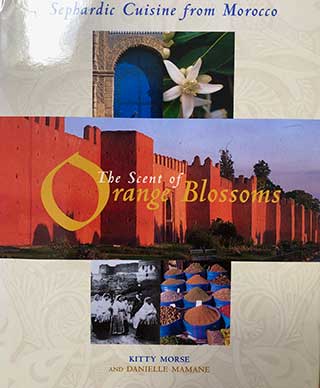Finalist, Best Foreign Cookery Book, Gourmand World Cookbook Awards, Perigueux, November 2002. Co-written with Danielle Mamane, of Fez, Morocco. Food photography by Owen Morse. . .
Online purchase information.
“Morse. . . teams up with Mamane, a resident of . . . Fez, to bring the unique cuisine of Moroccan Sephardic Jews to the American table . . . Also interspersed throughout are letters from mothers to their daughters recounting special events and personal reminiscences of Moroccan Sephardic life. . .These welcome additions to the recipes provide charming pictures of a lifestyle and culture, and make this volume as enjoyable to read as it is to cook from.”
Publishers’ Weekly, Nov. 19, 2001
The Scent of Orange Blossoms gets a mention in
the Jerusalem Post, on Jan. 1, 2011
http://www.jpost.com/LandedPages/PrintArticle.aspx?id=201573
from an article on oranges written by Faye Levy:
“Israelis are not alone in making liberal use of oranges in desserts. In Europe and in the New World, candied orange peel and grated orange zest – the aromatic outer colored part of the peel – are favorite flavorings for the traditional end-of-the-year fruit cakes. The most famous (some would say infamous) of this type of cake is the brandy-soaked English fruit cake, “the only food durable enough to become a family heirloom,” wrote Russell Baker in The New York Times.
German stollen, a holiday yeast cake, has sweet spices as well as candied orange peel. Candied peel and dried fruit also flavor the Italian yeast-leavened cake panettone, which has become popular throughout much of Latin America. In the US, it is prized by shoppers at ethnic markets ranging from Mexican to Middle Eastern to Filipino.
When I visited Siena, Italy, I sampled its specialty, panforte, which is so loaded with candied orange peel and nuts that it seemed like a confection.
Orange desserts are much loved in Sicily. Victoria Granof, author of Sweet Sicily, generously flavors toasted almond cookies with orange zest and juice. For a base for beverages, she makes almond milk syrup with orange flower water. Granof encourages bakers to prepare their own candied orange peel because it is “so often used in Sicilian baking that it is worth making up a batch yourself” and is superior to what is usually available at the store.
She adds candied peel to the ricotta cream filling for cannoli and to her biscotti-like spice cookies, which are flavored with orange blossom honey, cloves, black pepper and whole almonds. Her suggestion: If you are using packaged candied orange peel and find that it lacks flavor, grate a bit of fresh orange zest into your mixture – 1 teaspoon of freshly grated zest for each 1⁄4 cup candied peel . . .
And then there are the orange blossoms, which are used to make orange flower water, a treasured Middle Eastern flavoring for such pastries as ma’amoul, and also for jam. In her book The Scent of Orange Blossoms, Kitty Morse explains how to prepare orange blossom jam. As I looked at the delicate flowers of my orange tree, I could not imagine gathering enough to make the six cups needed for the recipe, which makes only a small amount of jam (Author’s note: Yes, I have made it, and it is exquisite!). Yet according to Morse, Sephardi cooks in Morocco “carefully gather the flowers in the early morning,” preferring those of bitter Seville oranges.
Morse’s great-grandmother made another rare treat – whole candied oranges. “Bowls of her delightful oranges confites appeared, as if by magic, within minutes of a guest’s entry into her tidy Casablanca salon.” To make them, the peeled oranges must be soaked in water, then boiled, drained, pierced and cooked very gently in syrup for two hours . . .”

Totes Funny